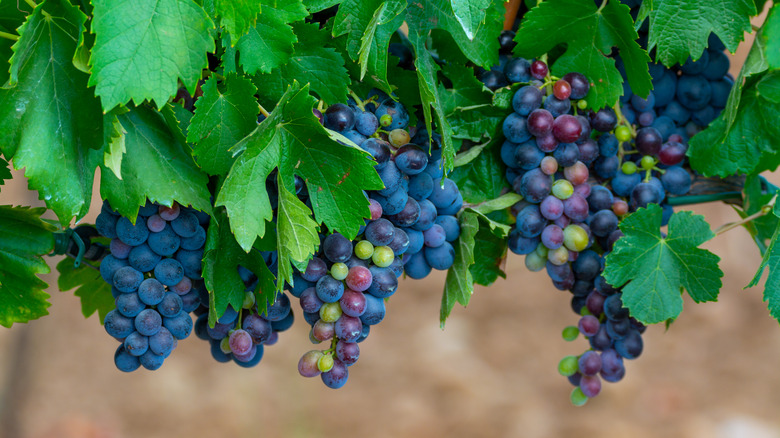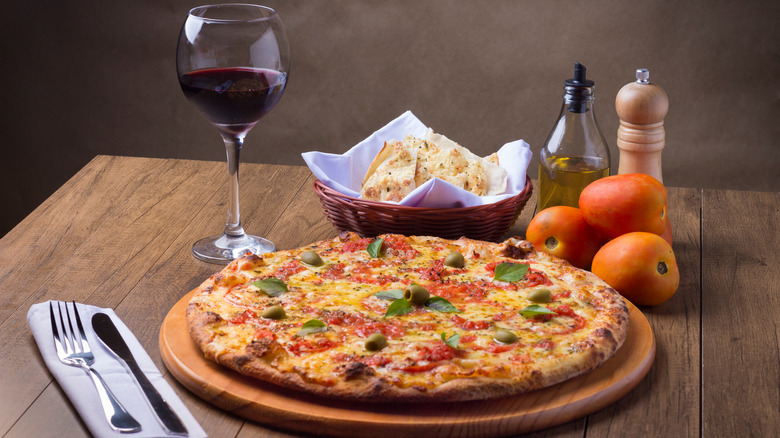What's Really So Important About Carignan Wine
For some, wine can be easily bifurcated into two areas: red and white. For others, it's a rich tapestry lush with varying shades, flavors, and nuances. No matter which camp you fall into, an important wine variety is beginning to come back into vogue, and you should most definitely be aware of it.
Wine Enthusiast writes that Carignan (pronounced "care-in-yen" according to Wine Folly) originated in the Spanish village of Cariñena in the 15th century, later being introduced to Sardinia sometime before the 18th century. They say that this red grape, which grows in warm climates, is naturally high in acidity and tannins. It is often blended with other red wine varieties, creating wines with a deep red color.
Wine Pigeon says that the Carignan grapes have dense, medium-sized berries which are juicy, thick-skinned, and black-blue colored. Nowadays, it's most commonly used in red wine blends throughout France.
Wine Enthusiast also explains that Carignan is grown in California, Chile, Mexico, and Croatia, and the wine tends to be full-bodied with "cherry notes, ripe tannins, and restrained acidity."
What is unique about Carignan?
According to Vinepair, Carignan had a difficult time making a name for itself compared with some other more immediately recognizable grapes and wines. However, while it was once pushed aside in favor of grapes that weren't as temperamental to grow – and produced less acrid wines – Carignan is now beginning to see a renaissance.
Caroline Connor, a Master of Wine, spoke with Vinepair, noting that "Carignan is widely planted and predominantly used as a blending grape for low-quality, mass-produced reds." Ivonne Nill told the same publication that Carignan was once actually referred to as "the bane of the European wine industry [and that] it never garnered any fans."
Vinepair writes that while Carignan was once considered too difficult to work with, it is now being celebrated due to its improved quality as the vines mature. "These bottlings proved that Carignan could make serious, complex, age-worthy reds, so long as it is pruned back significantly to lower yields," said the website. Ever since, Carignan has been making a comeback, with some comparing it to a "funky or gamey version of Syrah."
What does Carignan taste like?
While Carignan was once thought to be a low-quality grape option, it is being newly appreciated by winemakers. It makes "tremendously rich, red fruit-driven wines that will blow your mind," according to Wine Folly.
Wine Traveler says that Carignan can be very dry, with a sharper "punch" on the palate that one might expect from a similar red, and it sometimes has an "astringent mouthfeel." Other flavor notes are "leather saddle, olive, dry forest floor, tobacco, and burnt smoky brown sugar." Decanter echoes the point about Carignan's "austere tannins" and high acidity but says modern winemakers are utilizing it in new ways, such as carbonic maceration, which mellows out the grape's "innately robust nature" that can be overpowering for some.
According to Wine Pigeon, Carignan can be chilled, but the wine shouldn't be cold. They add that it should be opened and then allowed to sit at room temperature for 10 minutes before being consumed.
Carignan pairs well with many foods and contains the flavors of raspberry, cinnamon, star-anise, umami, and oak. It pairs well with heavier dishes, rich meats, and cheeses. VinePair states that it's also quite affordable and pairs well with pizza.
So the next time you're reaching for a red wine to accompany your meal – or simply to sip on while watching TV – ignore the pinot noirs and merlots and keep Carignan in mind instead.


